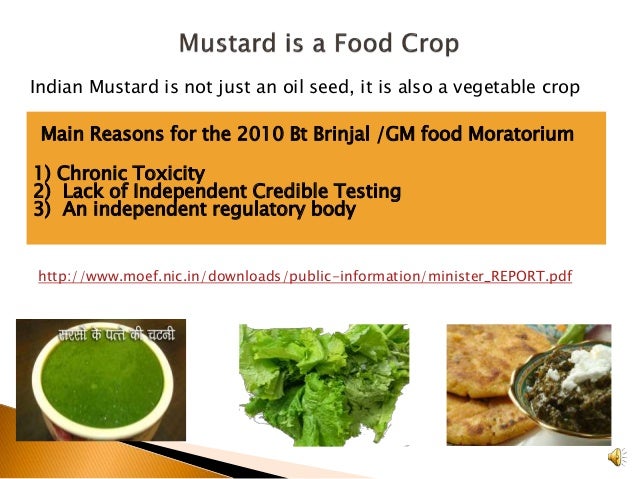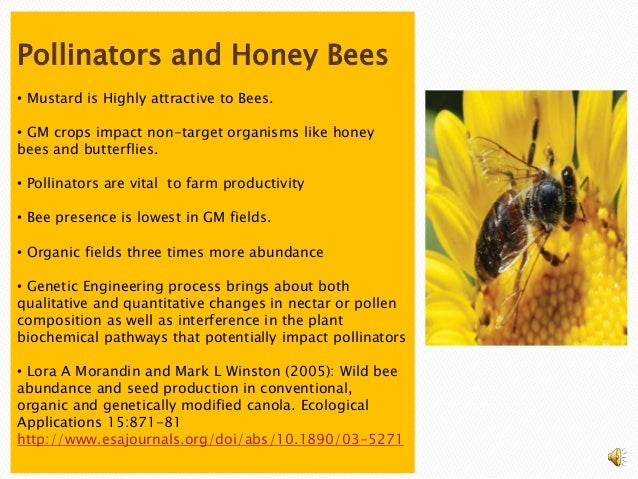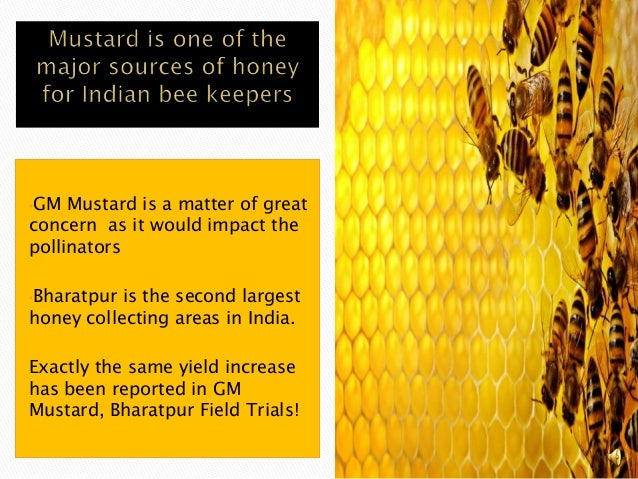First question what is a GM crop ?
A GM or transgenic crop is a plant that has a novel
combination of genetic material obtained through the use of modern
biotechnology. For example, a GM crop can contain a gene(s) that has been
artificially inserted instead of the plant acquiring it through pollination. The resulting plant is said to be “genetically modified” although
in reality all crops have been “genetically modified” from their original wild
state by domestication, selection, and controlled breeding over long periods of
time
GM
Mustard ....? ....Why is it in news ?

§ GM mustard (DMH11) is the first food crop to have applied for commercialisation
after the indefinite ban on the GM brinjal by the Jairam Ramesh-led environment
ministry in 2010.
So
..what was the RESULT ?
- Genetic Engineering Approval Committee recently put on hold the discussion on commercial use of genetically modified mustard.
Who applied for the commercialisation ?
 |
- Earlier (2003) it
was Pro-Agro Seeds India Private Ltd,
a subsidiary of multinational agro-chemical giant Bayer, which claimed its
GM variety containing four foreign genes, would raise the productivity of
mustard by 20-25 per cent, and improve oil quality.
- Now in 2016 the new GM mustard that has been developed by the Centre for Genetic Manipulation of Crop Plants, University of Delhi, and contains three alien genes – Bar, Barnase and Barstar -- also makes strikingly similar claims.
- At the same time, for reasons that can be explained, the
promoters of the earlier Pro-Agro GM mustard as well as Delhi University’s
new GM mustard deny the expression
of herbicide resistance, although both use a gene known for it.

Now the ARGUMENT whether INDIA at all needs
GM Mustard ?
Against GM MUSTARD !
First, lets see the story of OILSEEDS in past
few decades !
- Former Prime Minister Rajiv Gandhi was piqued over India’s rising imports. He was desperate to cut down on what the macro-economists call as the Current Account Deficit.
- Fuel, fertilizer and edible oils topped the import chart. The annual import bill for edible oils then hovered
between Rs 1500 and Rs 3000-crores. Knowing that edible oil imports could
be stopped since India had the ability to raise domestic oilseeds
production and also undertake processing, he launched a Technology Mission in Oilseeds in 1985.
In less than ten years, between 1986 and 1993, doubling of oilseeds
production was remarkable indeed, and was later dubbed as Yellow Revolution .
- From 11 million tonnes in 1986-87, oilseeds production jumped to 22 million tonnes in 1993-94. From a net importer, India became almost self-sufficient in edible oils.
- With 97 per cent self-sufficiency, India’s imports were
reduced to only 3 per cent of the requirement. The downslide began a few
years later when India deliberately began to lower the import duties
allowing cheaper and heavily subsidized edible oil to flow in. The more
the edible oil imports, the more the domestic processing industry pulled
down the shutters.
Iss scenario me
GM Mustard advocate karne wale kya bol rahe hai ?
- In
2002-03, when Pro-Agro was trying to market its GM mustard, the imports
had touched Rs 12,000-crore at the then prevailing prices.
- Thirteen years later, similar claims are being made to push
the new GM mustard – DMH 11 --
the annual import bill has
soared to Rs 60,000-crore.
Argument
against this !
- But the rising import bill, as is evident, is not because
of any shortfall in domestic production, but resulting from a flawed import-export policy that had
brought the import tariffs to almost zero.
- What is therefore needed is to raise the import tariffs to
about 70 per cent or higher (WTO allows India a maximum of 300 per cent import tariffs on edible oils)
and then provide a high price and an assured market, farmers would do the
rest.
The question that arises is whether India has
done enough to increase cropped area of mustard and push high-yielding
varieties developed by the Indian Council for Agricultural Research before
resorting to the heavily contested option of utilising GM technology.
ABOUT
PRODUCTIVITY ?
- GM mustard increases productivity by 20-25 per cent is
simply absurd.
- First of all, there is no known gene (or a cluster of
genes) that can increase productivity.
- Secondly, any GM variety is known to be as good as the hybrid in which the alien gene is inserted.
- Even if a gene simplifies the process of hybridization it
does not mean it raises crop productivity.
- To compare the yield of GM mustard (which essentially means
hybrid mustard) with traditional varieties therefore is only unfair.
- On the related issues of gene flow, contamination and the
growth of super weeds, the response so far has been unscientific.



----------------------------------------------------
COUNTERVIEW
(Pro GM Mustard) !
Anti-GMO Lobby
Has No Scientific Rationale To Stand On. It’s Time We Listened To Our Scientists
- This move might discourage R&D in Agriculture.
- India, given its large population, cannot afford to shut
out technological innovations in agriculture.
- Indian agricultural technology will remain in a rut
unless it gets high level political backing.
About
the BREED !
- DMH11 is a fully homegrown genetically engineered crop.
- The breed passed the Biosafety Research Level-1 (BRL-1) tests in Rajasthan in 2011-12 and 2012-13.
- The National Research Centre for Rapeseed-Mustard at Bharatpur coordinated the process involving the producers and the examiners.
- The Indian Agriculture Research Institute of Delhi and the Punjab Agricultural University cleared the breed in the BRL-2 tests in 2014-15.
- Creators say DMH11 facilitates 20-30 per cent more
yields than some of the better mustard varieties available now.
.jpg?auto=format&q=60&w=976) |
Economic Rationale given ?
- The economic imperative of cultivating a high-yielding
mustard crop is on a solid footing.
- Domestic production of edible oils has just not been
able to keep pace with demand, forcing India to resort to imports.
- Against an annual domestic production of around 7.5 million tonnes of edible oils, India
imports 14.5 million tonnes.
WAY
FORWARD !!
- What has hurt the government is its remarkable caginess in placing the biosafety assessments on GM mustard in the public domain. The Centre has taken the line that biosafety data could not be released because of intellectual property rights issue.
- However, even the Central Information Commission has ruled that biosafety data must be released in the larger public interest. Even the possible approval of GM Mustard by biotechnology regulator GEAC (Genetic Engineering Appraisal Committee) will lack credibility because of conflict of interest in the regulatory process. This has been red-flagged by the Parliamentary Standing Committee on Agriculture too.
- The Centre’s failure to enact the Biotechnology Regulatory Authority of India Bill and ensure statutory backing for the regulator before clearing field trials and commercial production is severely problematic. The Centre should have realised this after the failed attempt to introduce Bt-Brinjal.
- Centre’s unwillingness to engage with the scientific
community on these issues have not helped its cause. As a result,
activists ideologically opposed to GM crops have succeeded in thwarting
the Centre’s efforts with science becoming the major casualty amid the
claims and counterclaims of the two sides.

